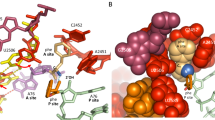Abstract
After the peptidyl-tRNA has occupied the P site and the aminoacyl-tRNA has been fully bound at the A site, the 3′-ends of the two tRNA residues are found close to each other in the region of the peptidyl transferase center (PTC) of the large ribosomal subunit. This is followed by a nucleophilic attack on the carbonyl group of the ester bond between the peptide residue and the tRNA moiety of the peptidyl-tRNA molecule by the amino group of the aminoacyl-tRNA molecule. As a result, an amide (peptide) bond is formed between the peptide residue and the aminoacyl-tRNA molecule (Fig. 11.1). The peptidyl-tRNA and the aminoacyl-tRNA are the substrates of this reaction. The peptidyl-tRNA is a donor substrate, and the aminoacyl-tRNA plays the part of an acceptor substrate. The products of the reaction are the deacylated tRNA in the P site and the peptidyl-tRNA with the peptide moiety elongated by one aminoacyl residue attached to the tRNA in the A site, as is shown schematically in Fig. 11.2.
Access this chapter
Tax calculation will be finalised at checkout
Purchases are for personal use only
Preview
Unable to display preview. Download preview PDF.
Similar content being viewed by others
References
Fahnestock, S., Neumann, H., Shashoua, V., and Rich, A. (1970) Ribosome-catalysed ester formation, Biochemistry 9:2477–2483.
Gale, E. F., Cundliffe, E., Reynolds, P. E., Richmond, M. H., and Waring, M. J. (1981) The Molecular Basis of Antibiotic Action, John Wiley & Sons, London.
Garrett, R. A., and Rodriguez-Fonseca, C. (1995) The peptidyl transferase center, in Ribosomal RNA: Structure, Evolution, Processing and Function in Protein Synthesis (R. A. Zimmermann and A. Dahlberg, eds.), pp. 329–357, CRC Press, Boca Raton, FL.
Gooch, J., and Hawtrey, A. O. (1975) Synthesis of thiol-containing analogues of puromycin and a study of their interaction with N-acetylphenylalanyl-transfer ribonucleic acid on ribosomes to form thioesters, Biochem. J. 149:209–220.
Kirillov, S., Porse, B. T., Vester, B., Woolley, P., and Garrett, R. A. (1997) Movement of the 3′-end of tRNA through the peptidyl transferase centre and its inhibition by antibiotics, FEBS Letters 406:223–233.
Krayevsky, A. A., and Kukhanova, M. K. (1979) The peptidyl-transferase center of ribosomes, Progr. Nucl. Acid Res. Mol. Biol. 23:1–51.
Monro, R. E., Staehelin, T., Celma, M. L., and Vazquez, D. (1969) The peptidyl transferase activity of ribosomes, Cold Spring Harbor Symp. Quant. Biol. 34:357–366.
Noller, H. F. (1991) Ribosomal RNA and translation, Annu. Rev. Biochem. 60:191–227.
Noller, H. F., Moazed, D., Stern, S., Rowers, T., Allen, P. V., Robertson, J. M., Weiser, B., and Triman, K. (1990) Structure of rRNA and its functional interactions in translation, in The Ribosome: Structure, Function, and Evolution (W. E. Hill, A. Dahlberg, R. A. Garrett, P. B. Moore, D. Schlessinger, and J. R. Warner, eds.) pp. 73–92, ASM Press, Washington, DC.
Pestka, S. (1977) Inhibitors of protein synthesis, in Molecular Mechanisms of Protein Biosynthesis (H. Weissbach and S. Pestka, eds.), pp. 468–553, Academic Press, New York.
Tarussova, N. B., Jacovleva, G. M., Victorova, L. S., Kukhanova, M. K., and Khomutov, R. M. (1981) Synthesis of an unnatural P-N bond catalysed with Escherichia coli ribosomes, FEBS Letters 130:85–87.
Victorova, L. S., Kotusov, L. S., Azhayev, A. V., Krayevsky, A. A., Kukhanova, M. K., and Gottikh, B. P. (1976) Synthesis of thioamide bond catalysed by E. coli ribosomes. FEBS Letters 68:215–218.
Author information
Authors and Affiliations
Rights and permissions
Copyright information
© 1999 Kluwer Academic/Plenum Publishers, New York
About this chapter
Cite this chapter
Spirin, A.S. (1999). Elongation Cycle, Step II: Transpeptidation (Peptide Bond Formation). In: Ribosomes. Cellular Organelles. Springer, Boston, MA. https://doi.org/10.1007/978-1-4615-7817-8_11
Download citation
DOI: https://doi.org/10.1007/978-1-4615-7817-8_11
Publisher Name: Springer, Boston, MA
Print ISBN: 978-0-306-46146-0
Online ISBN: 978-1-4615-7817-8
eBook Packages: Springer Book Archive




